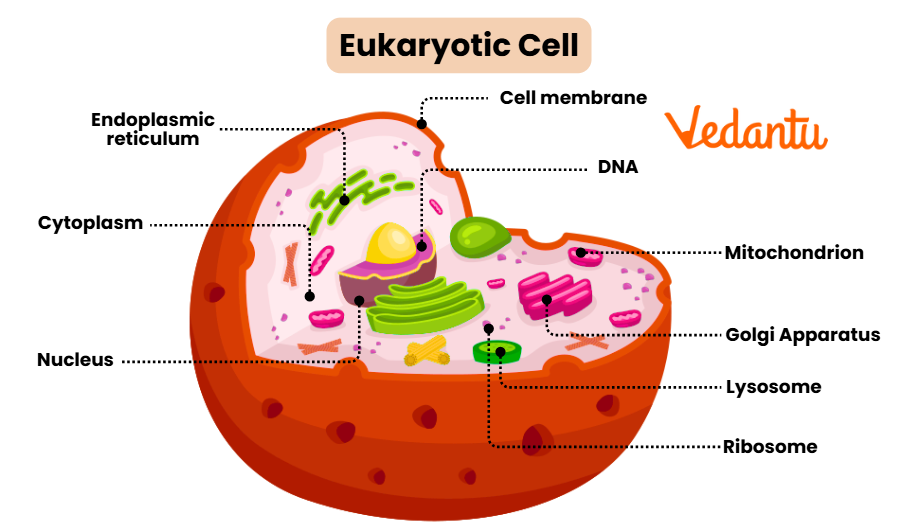Eukaryotic vs Prokaryotic Cells: Main Differences and Functions
A eukaryote is any cell or organism that possesses a clearly defined nucleus. In eukaryotic cells, the nucleus is surrounded by a nuclear membrane, and well-defined chromosomes containing hereditary material (DNA) are present within this compartment. This distinct feature separates eukaryotes from other organisms and is fundamental in how these cells function, grow, and carry out essential life processes.
Definition of Eukaryote
Eukaryotes are organisms whose cells contain a true, membrane-bound nucleus. This nucleus acts as the control center of the cell, safeguarding genetic material and regulating cellular activities. The presence of a nuclear membrane ensures protection and organization of DNA, supporting complex levels of genetic control.
Structure of Eukaryotic Cells
Eukaryotic cells have a complex internal structure. The defining component is the nucleus, but several other features are also present. These structures help eukaryotes perform specialized biological functions.
- Nucleus: Enclosed by a double membrane and contains chromosomes (DNA).
- Cytoplasm: The fluid region between the nucleus and the cell membrane where organelles are suspended.
- Cell Membrane: Surrounds and protects the cell, controlling the entry and exit of substances.
- Other Organelles: Structures such as mitochondria, endoplasmic reticulum, and Golgi apparatus are commonly found.

Key Features of Eukaryotic Cells
- Clearly defined nucleus encased in a nuclear envelope
- Presence of internal membranes and compartmentalized organelles
- DNA organized into chromosomes
These features permit eukaryotic cells to carry out more complex functions than cells without a true nucleus.
Scientific Significance
The nuclear membrane in eukaryotic cells serves as a barrier, protecting genetic information during cell activities. Chromosomes ensure orderly storage and transmission of hereditary traits. This structural setup allows for advanced processes, including selective gene expression and regulated cell division.
Examples of Eukaryotes
Eukaryotes include all plants, animals, fungi, and many single-celled organisms. Some common examples are:
- Plants (e.g., ferns, flowering plants)
- Animals (e.g., humans, birds, fish)
- Fungi (e.g., mushrooms, yeast)
- Single-celled organisms (such as amoeba and paramecium)
Comparison Table: Eukaryotes & Prokaryotes
| Feature | Eukaryote | Prokaryote |
|---|---|---|
| Nucleus | Present (membrane-bound) | Absent (nucleoid region) |
| Nuclear Membrane | Present | Absent |
| Chromosomes | Well-defined and linear | Circular, not encased in membrane |
Biological Significance of Eukaryotes
Eukaryotic cells are key to complex life forms because their compartmentalized structures support specialized tasks. With a nuclear membrane and organized chromosomes, eukaryotic cells are more adept at processing and storing genetic information.
Learn More and Explore Related Biology Topics
Practice and Next Steps
- Draw and label a eukaryotic cell, highlighting the nucleus and chromosomes.
- Compare the nucleus of a eukaryotic cell with the nucleoid of a prokaryote.
- Review and explain the role of the nuclear membrane in maintaining genetic material.
Understanding the structure and function of eukaryotic cells forms the foundation for advanced topics in cell biology, genetics, and physiology. Continue exploring these concepts through related articles and learning resources provided above.


FAQs on Eukaryote Explained: Definition, Features, and Key Examples
1. What is a eukaryote in simple words?
A eukaryote is any organism whose cells have a true nucleus enclosed by a membrane. Key points include:
- Eukaryotic cells contain membrane-bound organelles such as mitochondria, endoplasmic reticulum, and Golgi apparatus.
- The genetic material (DNA) is stored inside a well-defined nucleus.
- Examples are plants, animals, fungi, and protists.
2. Give five examples of eukaryotes.
Examples of eukaryotes include:
- Amoeba
- Yeast
- Sunflower
- Cow
- Humans
All of these organisms have cells with a nucleus and complex internal structures.
3. Which organism is a prokaryote: sunflower, bacteria, or cow?
Bacteria are prokaryotes.
- Prokaryotes have cells without a true, membrane-bound nucleus.
- Sunflower and cow are eukaryotes because they have a nucleus and organelles.
4. Why are eukaryotic cells important for multicellular life?
Eukaryotic cells support multicellular life by allowing cell specialization and higher organization.
- Their organelles create compartments for specialized functions.
- This enables complex structures, efficient functioning, and the development of tissues and organs in plants and animals.
5. What is the main difference between prokaryotic and eukaryotic cells?
The main difference is the presence of a membrane-bound nucleus in eukaryotic cells.
- Eukaryotes have a true nucleus and membrane-bound organelles.
- Prokaryotes lack a true nucleus (they have a nucleoid) and do not possess membrane-bound organelles.
6. List the four main kingdoms of eukaryotes and give one example for each.
The four main kingdoms of eukaryotes and their examples are:
- Protista: Amoeba
- Fungi: Yeast
- Plantae: Sunflower
- Animalia: Cow
7. Name the key organelles found only in eukaryotic cells.
Key organelles unique to eukaryotic cells are:
- Nucleus
- Mitochondria
- Endoplasmic reticulum (ER)
- Golgi apparatus
- Lysosomes
- Chloroplasts (in plant cells only)
8. How does cell division differ in eukaryotes and prokaryotes?
In eukaryotes, cell division occurs by mitosis and meiosis.
- Mitosis produces identical daughter cells; meiosis leads to gametes formation.
- Prokaryotes divide by binary fission, a simpler process without structures like spindle fibers or chromosomes with histones.
9. Which part of the eukaryotic cell controls the cell's activities?
The nucleus controls the activities of the eukaryotic cell.
- It contains the genetic material (DNA)
- It regulates gene expression and directs cell growth, division, and function.
10. Can you name a unicellular eukaryote?
Yes, yeast and Amoeba are unicellular eukaryotes.
- Both have a true nucleus and membrane-bound organelles despite consisting of only a single cell.
11. What are three main features that distinguish a eukaryotic cell?
Three main distinguishing features of eukaryotic cells are:
- Presence of a true, membrane-bound nucleus
- Possession of membrane-bound organelles (e.g., mitochondria, ER)
- Linear chromosomes with histone proteins
12. Which organelles are involved in energy production in eukaryotic cells?
Mitochondria are the main organelles responsible for energy (ATP) production in eukaryotic cells.
- In plant cells, chloroplasts also produce energy through photosynthesis.










